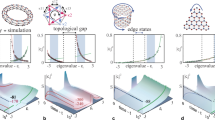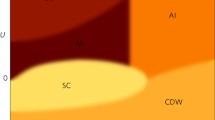Abstract
Transformations of cooperative electronic states by impacts of optical pumping and/or electrostatic doping is a new mainstream in physics of correlated systems. Here we present a semi-phenomenological modeling of spatio-temporal effects in a system where the light absorption goes through a channel creating the excitons—intra-molecular ones or bound electron–hole pairs—and finally the condensate of optical excitons feeds and stimulates phase transformations. Interacting with a near-critical order parameter and deformations, the excitons are subject to self-trapping. That locally enhances their density which can surpass a critical value to trigger the phase transformation, even if the mean density is below the required threshold. The model can be used e.g. as a simplified version of optically induced neutral-ionic transitions in organic chain compounds.




Similar content being viewed by others
References
Nasu, K.: Photoinduced Phase Transitions. World Scientific, Singapore (2004)
Brazovskii, S., Kirova, N. (eds.): Electronic States and Phases Induced by Electric or Optical Impacts. Eur. Phys. J. Spec. Top. 222(5) (2013)
Luty, T., Lewanowicz, A. (eds.): Proceedings of the 4th International Conference Photoinduced Phase Transitions and Cooperative Phenomena. Acta Phys. Pol. A, 121 (2012)
Brazovskii, S., Kirova, N., Monceau, P. (eds.): Proceedings of the International conference on Electronic Crystals (ECRYS-2012). Phys., B Condens. Matter 407(11) (2012)
Okamoto, H.: Ultrafast photoinduced phase transitions in one-dimensional organic correlated electron systems. In: Molecular Electronic and Related Materials-Control and Probe with Light, pp. 59–97. Transworld Research Network, Kerala (2010)
Miyamoto, T., Uemura, H., Okamoto, H.: J. Phys. Soc. Jpn. 81, 073703 (2012)
Nagaosa, N.: Solid State Commun.. 51, 179 (1986)
Nagaosa, N.: J. Phys. Soc. Jpn.. 55, 3488 (1986)
Rashba, E.I.: Self-trapping of excitons. In: Rashba, E.I., Sturge, M.D. (eds.) Excitons, p. 543. North-Holland, Amsterdam (1982).
Rashba, E.I.: Self-trapping of excitons. In: Rashba, E.I., Sturge, M.D. (eds.) Excitons, Selected Chapters, p. 543. North-Holland, Amsterdam (1982)
Tohyama, T.: Eur. Phys. J. Spec. Top. 222, 1065 (2013)
Ishihara, S., Ohara, J., Kanamori, Y.: Eur. Phys. J. Spec. Top. 222, 1125 (2013)
Yusupov, R., et al.: Nat. Phys. 6, 681 (2010)
Yusupov, R., et al.: J. Supercond. Nov. Magn. 24, 1191 (2011)
Stojchevska, L., Mertelj, T., Kusar, P., Vaskivskyi, I., Svetin, D., Brazovskii, S., Mihailovic, D.: Science (2013) (under revision)
Acknowledgements
The authors are grateful for hospitality of the Graduate School of Frontier Sciences at the University of Tokyo, where this work was initiated. We particularly acknowledge very stimulating input from Prof. H. Okamoto and members of his laboratory, and discussions with Prof. N. Nagaosa.
Author information
Authors and Affiliations
Corresponding author
Appendix
Appendix
The critical pumping n c1=|ψ c1|2 can be found as a point where the following conditions are fulfilled:
The critical value n c2 for the absolute instability of the phase 1 is reached when the barrier merges the minimum corresponding the phase 1: η 1=η b =η c2 at ∂W/∂η=0 and ∂ 2 W/∂η 2=0. We find the position and the threshold pumping as
Choosing a=1, b=6, c=8.2, g=2, we obtain for the strong excitons’ repulsion (k=1): η d =0.161, n d ≈0.0186, and for the weak one (k=0.1): η d =0.163, n d =0.0181. For the second threshold, independently of k and g: η c2=0.107, n c2=0.0242.
Rights and permissions
About this article
Cite this article
Brazovskii, S., Kirova, N. Excitonic Mechanism of Local Phase Transformations by Optical Pumping. J Supercond Nov Magn 27, 1009–1013 (2014). https://doi.org/10.1007/s10948-013-2432-9
Received:
Accepted:
Published:
Issue Date:
DOI: https://doi.org/10.1007/s10948-013-2432-9




